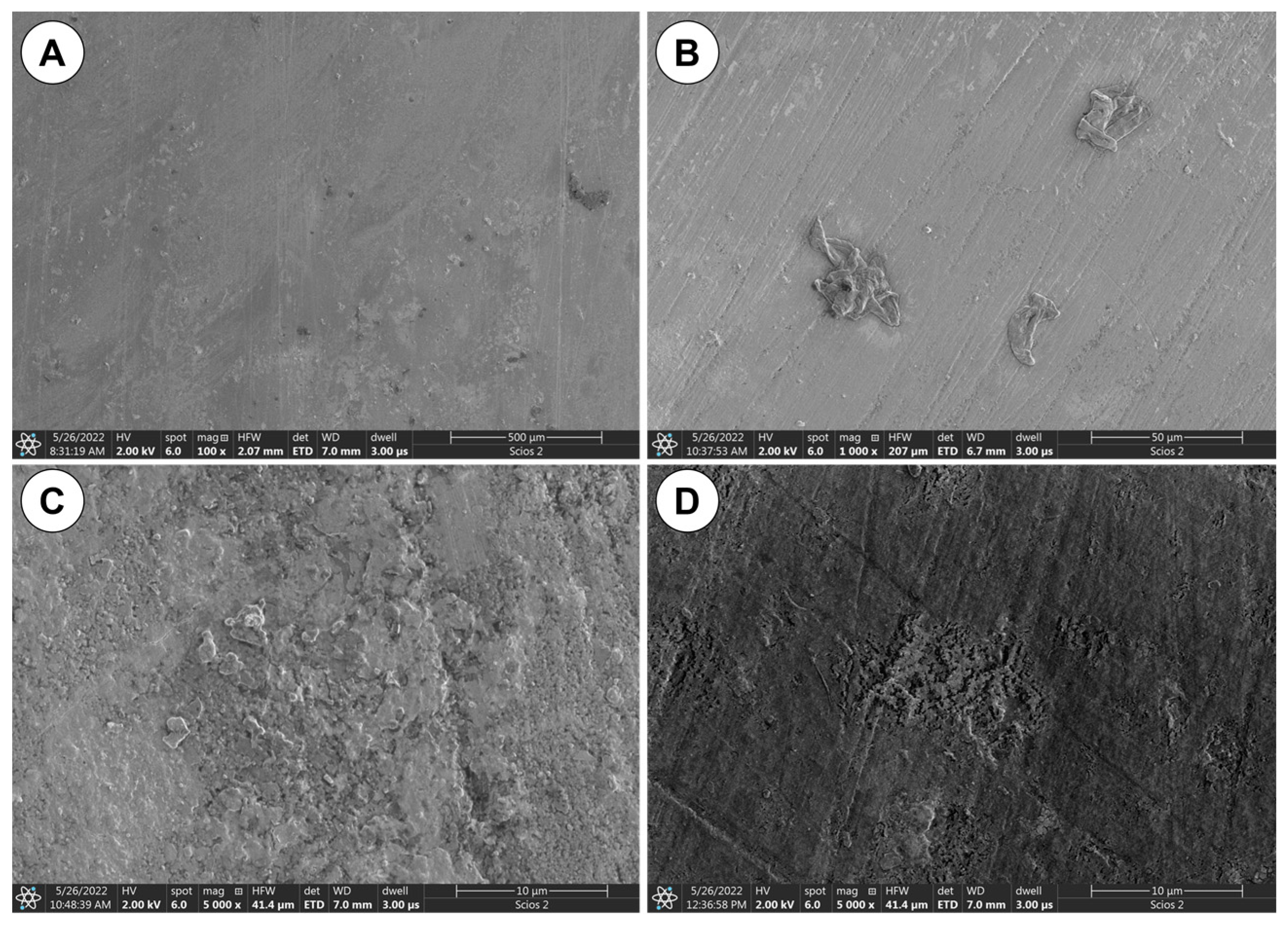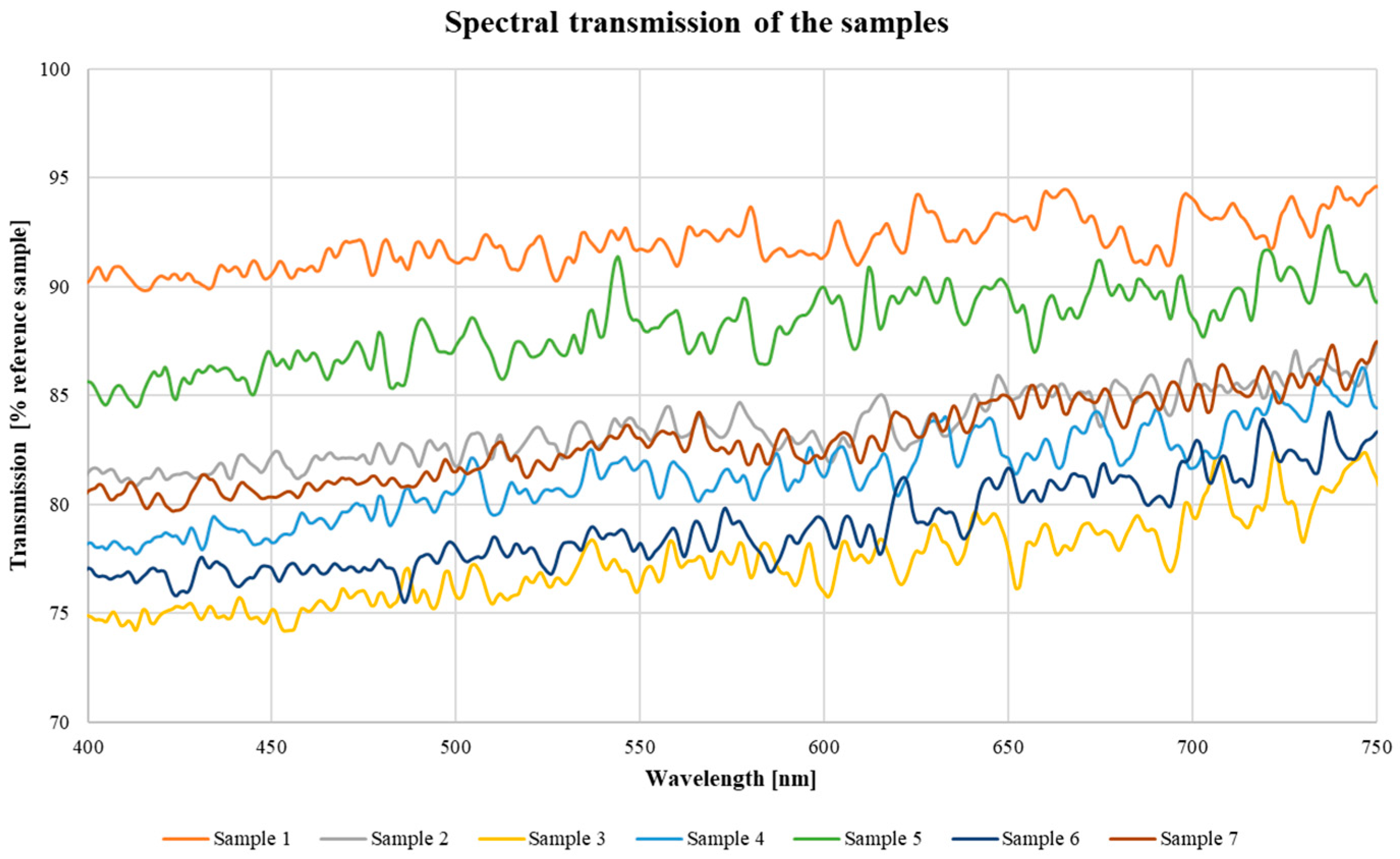Degradation of Polymethylmethacrylate (PMMA) Bioreactors Used for Algal Cultivation
Abstract
:1. Introduction
2. Materials and Methods
3. Results and Discussion
4. Conclusions
Author Contributions
Funding
Institutional Review Board Statement
Informed Consent Statement
Data Availability Statement
Conflicts of Interest
References
- McNaught, A.D. Compendium of Chemical Terminology, 2nd ed.; Blackwell Science: Oxford, UK, 1997; Volume 1669. [Google Scholar]
- Masojídek, J.; Torzillo, G. Mass Cultivation of Freshwater Microalgae. In Encyclopedia of Ecology; Elsevier: Amsterdam, The Netherlands, 2014; pp. 2226–2235. [Google Scholar]
- Wang, S.-K.; Stiles, A.R.; Guo, C.; Liu, C.-Z. Microalgae Cultivation in Photobioreactors: An Overview of Light Characteristics. Eng. Life Sci. 2014, 14, 550–559. [Google Scholar] [CrossRef]
- Chanquia, S.N.; Vernet, G.; Kara, S. Photobioreactors for Cultivation and Synthesis: Specifications, Challenges, and Perspectives. Eng. Life Sci. 2022, 22, 712–724. [Google Scholar] [CrossRef]
- Abou-shanab, R. Green Renewable Energy for Sustainable Socio-Economic Development. In Proceedings of the 14th International Conference on Environmental Science and Technology, Rhodes, Greece, 3–5 September 2015. [Google Scholar]
- Severin, T.S.; Brück, T.; Weuster-Botz, D. Validated Numerical Fluid Simulation of a Thin-Layer Cascade Photobioreactor in OpenFOAM. Eng. Life Sci. 2019, 19, 97–103. [Google Scholar] [CrossRef] [PubMed] [Green Version]
- Decker, E.L.; Reski, R. Current Achievements in the Production of Complex Biopharmaceuticals with Moss Bioreactors. Bioprocess Biosyst. Eng. 2008, 31, 3–9. [Google Scholar] [CrossRef] [PubMed]
- Jeffryes, C.; Severi, V.; Delhaye, A.; Urbain, B.; Grama, B.S.; Agathos, S.N. Energy Conversion in an Internally Illuminated Annular-plate Airlift Photobioreactor. Eng. Life Sci. 2016, 16, 348–354. [Google Scholar] [CrossRef]
- Zhang, K.; Kurano, N.; Miyachi, S. Optimized Aeration by Carbon Dioxide Gas for Microalgal Production and Mass Transfer Characterization in a Vertical Flat-Plate Photobioreactor. Bioprocess Biosyst. Eng. 2002, 25, 97–101. [Google Scholar] [CrossRef] [PubMed]
- Weissman, J.C.; Goebel, R.P. Design and Analysis of Microalgal Open Pond Systems for the Purpose of Producing Fuels: A Subcontract Report; Solar Energy Research Inst.: Golden, CO, USA, 1987. [Google Scholar] [CrossRef] [Green Version]
- Spolaore, P.; Joannis-Cassan, C.; Duran, E.; Isambert, A. Commercial Applications of Microalgae. J. Biosci. Bioeng. 2006, 101, 87–96. [Google Scholar] [CrossRef] [PubMed] [Green Version]
- Morocho-Jácome, A.L.; Sato, S.; Lara Capurro Guimarães, L.; Jesus, C.; Carvalho, J.C. Simultaneous Use of Sodium Nitrate and Urea as Nitrogen Sources Improves Biomass Composition of Arthrospira platensis Cultivated in a Tubular Photobioreactor. Eng. Life Sci. 2016, 16, 338–347. [Google Scholar] [CrossRef]
- Becker, W. Microalgae in Human and Animal Nutrition. In Handbook of Microalgal Culture; Blackwell Publishing Ltd.: Oxford, UK, 2007; pp. 312–351. [Google Scholar] [CrossRef]
- Chiu, S.-Y.; Tsai, M.-T.; Kao, C.-Y.; Ong, S.-C.; Lin, C.-S. The Air-Lift Photobioreactors with Flow Patterning for High-Density Cultures of Microalgae and Carbon Dioxide Removal. Eng. Life Sci. 2009, 9, 254–260. [Google Scholar] [CrossRef]
- Rodolfi, L.; Zittelli, G.C.; Bassi, N.; Padovani, G.; Biondi, N.; Bonini, G.; Tredici, M.R. Microalgae for Oil: Strain Selection, Induction of Lipid Synthesis and Outdoor Mass Cultivation in a Low-Cost Photobioreactor. Biotechnol. Bioeng. 2009, 102, 100–112. [Google Scholar] [CrossRef]
- Jacobi, A.; Steinweg, C.; Sastre, R.R.; Posten, C. Advanced Photobioreactor LED Illumination System: Scale-down Approach to Study Microalgal Growth Kinetics. Eng. Life Sci. 2012, 12, 621–630. [Google Scholar] [CrossRef]
- Flickinger, M.C.; Drew, S.W.; Murray, T.J.; Mehlman, M.J.; Gaden, E.; Blanch, W.; Chisti, Y.; Demain, A.; Dunnill, P.; Estell, D.; et al. Encyclopedia of Bioprocess Technology: Fermentation, Biocatalysis, and Bioseparation; John Wiley & Sons, Inc.: New York, NY, USA, 1999; ISBN 0-471-13822-3. [Google Scholar]
- Pulz, O. Photobioreactors: Production Systems for Phototrophic Microorganisms. Appl. Microbiol. Biotechnol. 2001, 57, 287–293. [Google Scholar] [CrossRef]
- de Monsores, K.G.C.; da Silva, A.O.; de Oliveira, S.S.A.; Rodrigues, J.G.P.; Weber, R.P. Influence of Ultraviolet Radiation on Polymethylmethacrylate (PMMA). J. Mater. Res. Technol. 2019, 8, 3713–3718. [Google Scholar] [CrossRef]
- Laouamri, H.; Giljean, S.; Arnold, G.; Kolli, M.; Bouaouadja, N.; Tuilier, M.H. Roughness Influence on the Optical Properties and Scratch Behavior of Acrylic Coating Deposited on Sandblasted Glass. Prog. Org. Coat. 2016, 101, 400–406. [Google Scholar] [CrossRef]
- Kaddouri, A.; Serier, B.; Kaddouri, K. Mohamed Belhouari Experimental Analysis of the Physical Degradation of Polymers—The Case of Polymethyl Methacrylate. Frat. Integrita Strutt. 2020, 14, 66–80. [Google Scholar] [CrossRef]
- Vohlídal, J. Polymer Degradation: A Short Review. Chem. Teach. Int. 2021, 3, 213–220. [Google Scholar] [CrossRef]
- ASM International. Characterization and Failure Analysis of Plastics; ASM International: Materials Park, OH, USA, 2003; 329p, ISBN 978-0-87170-789-5. [Google Scholar]
- ISO 11562(M1); Geometrical Product Specifications (GPS)—Surface texture: Profile Method—Metrological Characteristics of Phase Correct Filters. 1998. Available online: https://www.iso.org/standard/21977.html (accessed on 30 May 2023).
- Rao, C.M.; Venkatasubbaiah, K.; Rao, K.J. Experimental Investigation of Surface Roughness Characteristics Ra, Rq and Rz. Int. J. Hybrid Inf. Technol. 2016, 9, 373–388. [Google Scholar] [CrossRef]
- Rushan, N.H.; Mat Yasin, N.H.; Said, F.M. The Effect of Culture Medium on the Oil Yield and Fatty Acid Methyl Ester of Freshwater Microalgae Chlorella vulgaris. Chem. Eng. Commun. 2021, 208, 592–600. [Google Scholar] [CrossRef]
- Ali, U.; Karim, K.J.B.A.; Buang, N.A. A Review of the Properties and Applications of Poly (Methyl Methacrylate) (PMMA). Polym. Rev. 2015, 55, 678–705. [Google Scholar] [CrossRef]
- Sikora, A.; Czylkowski, D.; Hrycak, B.; Moczała-Dusanowska, M.; Łapiński, M.; Dors, M.; Jasiński, M. Surface Modification of PMMA Polymer and Its Composites with PC61BM Fullerene Derivative Using an Atmospheric Pressure Microwave Argon Plasma Sheet. Sci. Rep. 2021, 11, 9270. [Google Scholar] [CrossRef]
- Rougeot, R.; Flamary, R.; Mary, D.; Aime, C. Influence of Surface Roughness on Diffraction in the Externally Occulted Lyot Solar Coronagraph. Astron. Astrophys. 2019, 626, A1–A13. [Google Scholar] [CrossRef] [Green Version]
- Lu, T.; Solis-Ramos, E.; Yi, Y.; Kumosa, M. UV Degradation Model for Polymers and Polymer Matrix Composites. Polym. Degrad. Stab. 2018, 154, 203–210. [Google Scholar] [CrossRef]
- Cho, K.L.; Liaw, I.I.; Wu, A.H.F.; Lamb, R.N. Influence of Roughness on a Transparent Superhydrophobic Coating. J. Phys. Chem. C 2010, 114, 11228–11233. [Google Scholar] [CrossRef]
- Physical Properties of PMMA and PC ★ PlasticExpress. Available online: https://plasticexpress.pl/wlasciwosci-plexi-i-poliweglanu (accessed on 21 April 2023).







| Sample | 0 | 1 | 2 | 3 | 4 | 5 | 6 | 7 |
|---|---|---|---|---|---|---|---|---|
| Number of scratches per 6.75 × 104 μm2 | 1 | 7 | 17 | 48 | 29 | 9 | 33 | 25 |
| Sample | 1 | 2 | 3 | 4 | 5 | 6 | 7 | Average |
|---|---|---|---|---|---|---|---|---|
| Young Modulus [GPa] | 3.03 | 2.92 | 3.00 | 3.08 | 2.92 | 2.90 | 2.86 | 3.00 |
Disclaimer/Publisher’s Note: The statements, opinions and data contained in all publications are solely those of the individual author(s) and contributor(s) and not of MDPI and/or the editor(s). MDPI and/or the editor(s) disclaim responsibility for any injury to people or property resulting from any ideas, methods, instructions or products referred to in the content. |
© 2023 by the authors. Licensee MDPI, Basel, Switzerland. This article is an open access article distributed under the terms and conditions of the Creative Commons Attribution (CC BY) license (https://creativecommons.org/licenses/by/4.0/).
Share and Cite
Borucinska, E.; Zamojski, P.; Grodzki, W.; Blaszczak, U.; Zglobicka, I.; Zielinski, M.; Kurzydlowski, K.J. Degradation of Polymethylmethacrylate (PMMA) Bioreactors Used for Algal Cultivation. Materials 2023, 16, 4873. https://doi.org/10.3390/ma16134873
Borucinska E, Zamojski P, Grodzki W, Blaszczak U, Zglobicka I, Zielinski M, Kurzydlowski KJ. Degradation of Polymethylmethacrylate (PMMA) Bioreactors Used for Algal Cultivation. Materials. 2023; 16(13):4873. https://doi.org/10.3390/ma16134873
Chicago/Turabian StyleBorucinska, Ewa, Przemyslaw Zamojski, Wojciech Grodzki, Urszula Blaszczak, Izabela Zglobicka, Marcin Zielinski, and Krzysztof J. Kurzydlowski. 2023. "Degradation of Polymethylmethacrylate (PMMA) Bioreactors Used for Algal Cultivation" Materials 16, no. 13: 4873. https://doi.org/10.3390/ma16134873





